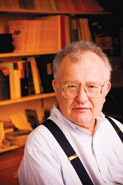Now hear this: Auditory scene analysis
Now hear this: Auditory scene analysis McGill University
User Tools (skip):
Now hear this: Auditory scene analysis
If you have ever been in a noisy room and wondered how you were able to distinguish the voice of a friend from the general din, psychology professor Albert Bregman is someone worth listening to. He and the other members of the Auditory Research Lab at McGill study the perceptual organization of sound. They investigate how our brain sorts the cacophony of our complex environment and identifies distinct streams of sounds. The process by which the brain organizes information from our world's sonic "scene," known as auditory scene analysis, is fundamental to how we perceive speech and music.

Psychology professor Albert Bregman
Claudio Calligaris
Walking down the street we encounter honking cars, people talking and music emanating from shops and restaurants. The acoustic energy produced by all of these sources arrives at our ears mixed together as a single pressure wave at the eardrum. Despite this auditory puzzle, we can discern single streams of sounds, such as a violin playing or a person talking. "If it wasn't for this mechanism the brain might combine syllables from two different speakers to make a spurious word," Bregman says. But instead we can recognize a single voice in a noisy room and distinguish the different instruments in a piece of music. How the brain does this was not known until a surprising finding by Bregman.
In 1969, while working on research involving memory and hearing, Bregman played noises, derived from sources such as a dentist's drill and water splashing, to human listeners. The sounds aired as brief bursts, only a tenth of a second long. He observed that listeners unconsciously organized alike noises into groups. He then played a simpler pattern and found a similar result. A rapid sequence of alternating high and low pitch tones were perceived as separate high and low streams, and Bregman hypothesized that the brain sorts sounds according to what it interprets to be the different sources that have produced them -- a rather complex task. "The first thing the brain does is sort the incoming array of sounds into a large number of frequency components." Bregman says. "It must then determine which combination of these components, comes from the same source, such as the voice of a particular person."
Bregman discovered that the brain uses certain cues in sounds to lump together similar sounds from the haphazard jumble presented to our ears, and to isolate distinct streams, each generated by a different source. These cues include when a sound is initiated, its volume, its frequency, the location of its source and how these qualities and others change over time. "Different cues compete, and different cues have different strengths."
Bregman's discoveries about how the auditory system analyzes sounds have resulted in many practical applications. The principles have been applied to develop voice recognition systems that discern speech from background noise, and efforts are being made to design "smart" hearing aids that help users segregate sound sources. Similarly, researchers hope that the application of auditory scene analysis will lead to the development of superior cochlear implants. Knowing how the brain isolates streams of sounds could also improve workplace safety through the development of alarms on machinery that are easy to hear in a noisy environment, or better alarms for aircraft cockpits.
Bregman has been called a pioneer in the psychology of hearing for his groundbreaking discoveries in the field of auditory scene analysis, and the breadth of applications of his research continues to grow. An email list that he started a few years ago to connect experts interested in research involving the auditory system now boasts almost a thousand members in fields as diverse as engineering, computer science, linguistics, physics, mathematics and biology. Bregman has even participated in musicology research to investigate how we perceive and organize music as we hear it, and how composers instinctively write music with those methods of perception and organization in mind.
WARM-SPARK (Writing About Research at McGill-Students Promoting Awareness of Research Knowledge) is a program sponsored by the Faculty of Science, the Offices of the Vice-Principal (Research) and University Relations, NSERC, the Faculty of Engineering and the Faculty of Agriculture & Environmental Sciences. See www.spark.mcgill.ca for more information and articles.
